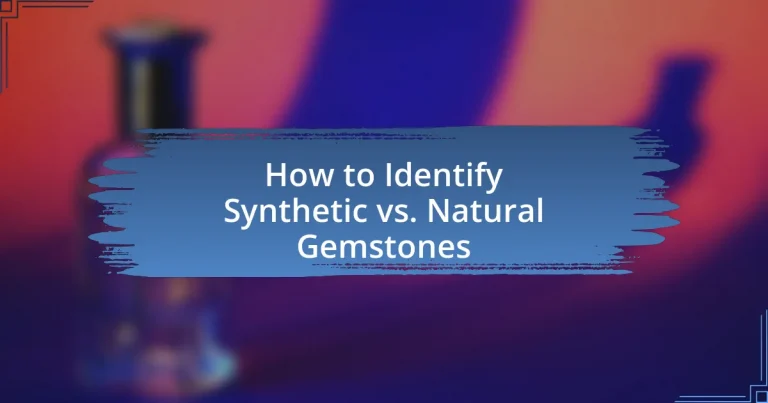The article focuses on the identification of synthetic versus natural gemstones, highlighting their distinct characteristics and formation processes. Synthetic gemstones are man-made in laboratories, replicating the properties of natural gemstones formed through geological processes over millions of years. Key differences include the presence of inclusions, color uniformity, and market value, with natural gemstones typically being rarer and more valuable. The article also outlines various identification methods, including visual inspection, refractive index measurement, and advanced techniques like spectroscopy, emphasizing the importance of accurate identification for consumer trust and market integrity.

What are Synthetic and Natural Gemstones?
Synthetic gemstones are man-made stones created in laboratories that replicate the chemical, physical, and optical properties of natural gemstones. Natural gemstones, on the other hand, are formed through geological processes over millions of years and are mined from the earth. The distinction between the two lies in their origin; synthetic gemstones are produced using advanced technology, while natural gemstones occur naturally in the environment. For example, synthetic rubies can be created using the Verneuil process, which mimics the natural crystallization process, whereas natural rubies are formed under specific geological conditions.
How do Synthetic and Natural Gemstones differ?
Synthetic gemstones are created in laboratories through artificial processes, while natural gemstones are formed through geological processes over millions of years. The primary difference lies in their origin; synthetic gemstones often have fewer inclusions and more uniform color, making them easier to identify under magnification. Natural gemstones typically exhibit unique imperfections and variations due to their natural formation processes. For instance, a study by the Gemological Institute of America highlights that synthetic diamonds can be distinguished from natural ones through specific optical and chemical tests, confirming the differences in their formation and characteristics.
What are the defining characteristics of Natural Gemstones?
Natural gemstones are defined by their formation through geological processes without human intervention. These characteristics include their unique crystal structures, natural inclusions, and specific mineral compositions that reflect their origin. For instance, natural diamonds form under high-pressure conditions deep within the Earth, while sapphires and rubies are varieties of corundum that develop in metamorphic rocks. Additionally, natural gemstones often exhibit variations in color and clarity due to environmental factors during their formation, which can be identified through gemological testing. These defining traits distinguish them from synthetic gemstones, which are created in laboratories and lack the unique geological history of natural stones.
What are the defining characteristics of Synthetic Gemstones?
Synthetic gemstones are man-made stones that possess the same chemical composition, physical properties, and optical characteristics as their natural counterparts. These gemstones are typically created in controlled environments using methods such as the Verneuil process or hydrothermal synthesis, which allows for the replication of natural gemstone formation. A defining characteristic of synthetic gemstones is their lack of inclusions or imperfections, which are often present in natural stones due to their geological formation processes. Additionally, synthetic gemstones can be produced in a variety of colors and sizes, often more consistently than natural gemstones, making them more uniform in appearance. The ability to create these stones in a laboratory setting also allows for greater availability and lower prices compared to natural gemstones.
Why is it important to distinguish between Synthetic and Natural Gemstones?
Distinguishing between synthetic and natural gemstones is crucial because it affects value, authenticity, and consumer trust. Natural gemstones typically hold higher market value due to their rarity and unique formation processes, while synthetic gemstones, although visually similar, are often less expensive and produced in controlled environments. According to the Gemological Institute of America, natural gemstones can appreciate in value over time, whereas synthetic stones may not retain the same investment potential. This distinction is essential for buyers to make informed purchasing decisions and for sellers to maintain transparency in the market.
What impact does the distinction have on value?
The distinction between synthetic and natural gemstones significantly impacts their value, with natural gemstones generally commanding higher prices due to their rarity and perceived authenticity. Natural gemstones are formed through geological processes over millions of years, making them unique and sought after by collectors and investors. In contrast, synthetic gemstones, while often visually identical, are created in laboratories and are more abundant, leading to lower market values. For example, a natural diamond can sell for thousands of dollars per carat, while a synthetic diamond may only fetch a fraction of that price, often around 20-40% less, reflecting the market’s valuation of authenticity and rarity.
How does the distinction affect consumer trust?
The distinction between synthetic and natural gemstones significantly affects consumer trust by influencing perceptions of authenticity and value. Consumers tend to trust natural gemstones more due to their rarity and the belief that they possess unique qualities, which are often associated with emotional and financial investment. A study by the Gemological Institute of America (GIA) found that 70% of consumers prefer natural gemstones, indicating a strong preference rooted in trust and perceived value. This preference is reinforced by the understanding that natural gemstones undergo geological processes over millions of years, whereas synthetic gemstones are created in laboratories, leading to skepticism about their long-term value and authenticity.

What Methods are Used to Identify Gemstones?
Various methods are used to identify gemstones, including visual inspection, refractive index measurement, and spectroscopy. Visual inspection involves examining the gemstone’s color, clarity, cut, and carat weight, which can provide initial clues about its identity. Refractive index measurement utilizes a refractometer to determine how light bends as it passes through the gemstone, helping to distinguish between different types. Spectroscopy analyzes the light spectrum emitted or absorbed by the gemstone, revealing its chemical composition and aiding in identification. These methods are widely accepted in gemology and are essential for differentiating between synthetic and natural gemstones.
How can visual inspection help in identification?
Visual inspection aids in the identification of synthetic versus natural gemstones by allowing gemologists to observe key physical characteristics. These characteristics include inclusions, color zoning, and surface features that differ between synthetic and natural stones. For instance, natural gemstones often exhibit unique inclusions formed during their geological development, while synthetic gemstones may show gas bubbles or curved striations from the manufacturing process. Studies have demonstrated that trained professionals can accurately distinguish between the two types of gemstones through visual inspection, with success rates exceeding 90% in controlled environments.
What features should be observed during visual inspection?
During visual inspection of gemstones, key features to observe include clarity, color, inclusions, and surface characteristics. Clarity refers to the presence of internal or external flaws, which can indicate whether a gemstone is natural or synthetic. Color should be examined for uniformity and saturation, as synthetic stones often exhibit overly perfect hues. Inclusions, or natural imperfections, can provide evidence of a gemstone’s origin; natural stones typically have unique inclusions, while synthetic stones may have gas bubbles or curved striations. Surface characteristics, such as scratches or polish quality, can also reveal information about the gemstone’s treatment history. These observations are critical for distinguishing between synthetic and natural gemstones, as they often exhibit distinct visual traits.
How do inclusions differ between Synthetic and Natural Gemstones?
Inclusions in synthetic gemstones differ from those in natural gemstones primarily in their origin and characteristics. Natural gemstones typically contain inclusions that are formed during their geological development, such as minerals, gas bubbles, or other natural materials, which can provide insights into their formation history. In contrast, synthetic gemstones often have inclusions that are indicative of the manufacturing process, such as gas bubbles or curved growth lines, which are not found in natural stones. These differences can be observed under magnification, where natural inclusions tend to be more varied and complex, while synthetic inclusions are often more uniform and systematic, reflecting the controlled conditions of their creation.
What advanced techniques are available for gemstone identification?
Advanced techniques for gemstone identification include spectroscopy, microscopy, and chemical analysis. Spectroscopy, such as Raman and infrared spectroscopy, allows for the identification of gemstones based on their unique light absorption and emission properties. Microscopy, particularly using polarized light microscopy, helps in examining inclusions and crystal structures that differentiate natural from synthetic stones. Chemical analysis techniques, like X-ray fluorescence (XRF) and energy-dispersive X-ray spectroscopy (EDX), provide elemental composition data that can confirm the origin of the gemstone. These methods are widely accepted in gemology for their accuracy and reliability in distinguishing between synthetic and natural gemstones.
How does spectroscopy aid in identifying gemstones?
Spectroscopy aids in identifying gemstones by analyzing the light absorption and emission characteristics of the materials. This technique allows gemologists to determine the chemical composition and structural properties of gemstones, which are crucial for distinguishing between synthetic and natural varieties. For example, specific absorption lines in the spectrum can indicate the presence of certain elements or inclusions that are typical of natural stones, while synthetic gemstones often exhibit different spectral signatures due to their manufacturing processes. Studies have shown that infrared and ultraviolet-visible spectroscopy can effectively differentiate between these types based on their unique spectral features, providing a reliable method for gemstone identification.
What role does refractive index play in identification?
The refractive index is crucial in identifying gemstones as it measures how light bends when entering a material, allowing differentiation between synthetic and natural stones. Each gemstone has a specific refractive index that can be measured using tools like a refractometer, providing a reliable means of identification. For instance, natural diamonds have a refractive index of approximately 2.42, while synthetic diamonds may exhibit slight variations, aiding gemologists in distinguishing between the two. This property is fundamental in gemology, as it provides a quantitative basis for classification and verification of gemstone authenticity.

What Tools and Resources are Available for Identification?
Tools and resources available for the identification of synthetic versus natural gemstones include gemological microscopes, refractometers, and spectroscopy equipment. Gemological microscopes allow for detailed examination of inclusions and surface features, which can indicate whether a gemstone is natural or synthetic. Refractometers measure the refractive index of gemstones, providing critical data for identification, as synthetic stones often have different optical properties than their natural counterparts. Spectroscopy equipment analyzes the light absorption and emission characteristics of gemstones, revealing unique spectral signatures that can differentiate between synthetic and natural origins. These tools are widely used in gemology and are essential for accurate gemstone identification.
What basic tools can be used for gemstone identification?
Basic tools for gemstone identification include a loupe, a refractometer, and a hardness testing kit. A loupe, typically 10x magnification, allows for close examination of inclusions and surface characteristics. A refractometer measures the refractive index, which helps distinguish between different gemstones based on their optical properties. A hardness testing kit, often using the Mohs scale, assesses a gemstone’s resistance to scratching, providing insight into its identity. These tools are essential for gemologists and hobbyists alike, as they facilitate accurate identification of both synthetic and natural gemstones.
How does a loupe enhance the identification process?
A loupe enhances the identification process by providing magnification that allows gemologists to closely examine the internal and external features of gemstones. This detailed inspection reveals critical characteristics such as inclusions, surface blemishes, and growth patterns, which are essential for distinguishing between synthetic and natural gemstones. For instance, natural gemstones often exhibit unique inclusions that are absent in synthetic counterparts, making the loupe an invaluable tool for accurate identification.
What is the significance of a gem tester?
A gem tester is significant because it accurately distinguishes between synthetic and natural gemstones. This device utilizes various methods, such as thermal conductivity and refractive index measurements, to assess the properties of gemstones. For instance, natural diamonds and synthetic diamonds exhibit different thermal conductivities, allowing gem testers to identify their origins effectively. The ability to differentiate these gemstones is crucial for consumers and jewelers, as it ensures authenticity and value in the gemstone market.
Where can one find professional gemstone identification services?
Professional gemstone identification services can be found at gemological laboratories, jewelry appraisal services, and specialized gemstone retailers. These facilities employ certified gemologists who utilize advanced equipment and techniques to accurately assess gemstones. For instance, the Gemological Institute of America (GIA) is a renowned institution that provides comprehensive gemstone identification and grading services, ensuring reliable results based on established gemological standards.
What qualifications should a professional gemologist have?
A professional gemologist should have a degree in gemology or a related field, along with certification from a recognized institution such as the Gemological Institute of America (GIA) or the International Gemological Institute (IGI). These qualifications ensure that the gemologist possesses the necessary knowledge and skills to accurately identify and evaluate gemstones, including distinguishing between synthetic and natural varieties. Certification programs typically include comprehensive training in gemstone identification, grading, and appraisal, which are critical for professional practice in the field.
How can online resources assist in gemstone identification?
Online resources assist in gemstone identification by providing access to comprehensive databases, educational materials, and community forums. These platforms offer detailed descriptions, images, and characteristics of various gemstones, enabling users to compare their specimens against established criteria. For instance, websites like Gemdat and the International Gem Society provide extensive information on gemstone properties, including hardness, refractive index, and specific gravity, which are essential for accurate identification. Additionally, online forums allow enthusiasts and experts to share insights and experiences, further enhancing the identification process through collaborative knowledge.
What are some practical tips for identifying Synthetic vs. Natural Gemstones?
To identify synthetic versus natural gemstones, examine their inclusions and surface features under magnification. Natural gemstones typically contain unique inclusions formed during their geological development, while synthetic gemstones often have gas bubbles or curved striations indicative of their lab-created origins. Additionally, utilize a refractometer to measure the refractive index; natural stones usually exhibit a wider range of indices due to their formation processes, whereas synthetic stones often have consistent values. Furthermore, consider conducting a UV light test; many synthetic gemstones fluoresce differently than their natural counterparts. These methods are supported by gemological studies that highlight the distinct physical properties of synthetic and natural stones.
How can one educate themselves on gemstone characteristics?
To educate oneself on gemstone characteristics, one should study gemology through accredited courses and resources. Institutions like the Gemological Institute of America (GIA) offer comprehensive programs that cover the properties, identification, and valuation of gemstones. Additionally, reading books such as “Gemstones of the World” by Walter Schumann provides detailed information on various gemstones, including their physical and optical properties. Engaging with online platforms, such as webinars and forums dedicated to gemology, can also enhance understanding through community discussions and expert insights.
What common mistakes should be avoided during identification?
Common mistakes to avoid during identification of synthetic versus natural gemstones include relying solely on visual inspection, neglecting to use appropriate testing tools, and failing to consider the gemstone’s origin. Visual inspection can be misleading, as synthetic stones may closely resemble natural ones. Not utilizing tools such as refractometers or spectroscopes can lead to inaccurate conclusions, as these instruments provide critical data on the gemstone’s properties. Additionally, overlooking the importance of the gemstone’s origin can result in misidentification, as certain characteristics are unique to specific sources.


